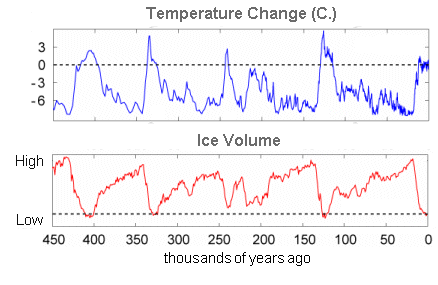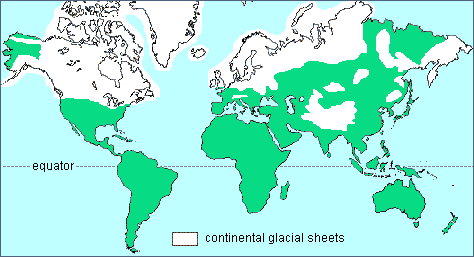The evolutionary surge that led to Homo habilis began during the transition between the Pliocene and Pleistocene Epochs around 2.5 million years ago when climates were becoming cooler and drier. All later species of Homo evolved during the Pleistocene (2,600,000-11,700 years ago). This was generally a time of more extreme world cooling and recurrent glaciations (ice ages). During the coldest periods, global temperatures dropped by about 9 F. (5 C.) and long-lasting ice sheets spread out from the poles and high mountains. Between the four or more major glaciations of the Pleistocene, there were interglacial warming periods with temperatures similar to now. Both the glacials and the interglacials lasted tens of thousands of years. Very likely, we are now in an interglacial that began 10,000-12,000 years ago.
|
|||||||||||||||||||||||||||||||||||||||||||||||||||||||||
 |
|||||||||||||||||||||||||||||||||||||||||||||||||||||||||
| *
These time ranges are
approximations and do not reflect the fact that temperature changes between glacials and interglacials usually
occurred over thousands of years. (principal sources: P. Gibbard and T. Van Kolfschoten (2004) "The Pleistocene and Holocene Epochs", ch. 22, in F. M. Gradstein et.al., A Geologic Time Scale (2004), Cambridge University Press) ** The use of pre-Illinoan climate stage designations for North America is controversial because the terms have been used inconsistently to describe different climatic events. Many geologists prefer for now to lump the Yarmouth, Kansan, Aftonian, and Nebraskan together into a single pre-Illinoian stage. |
|||||||||||||||||||||||||||||||||||||||||||||||||||||||||
The continents of the northern hemisphere were more affected by glaciations than the southern ones, which generally remained mostly tropical and subtropical, though more humid during ice ages. The coldest regions of the world became arctic deserts. However, the great hot deserts of North Africa and Western North America today were mostly vast grasslands with large permanent lakes and abundant large game animals during the Pleistocene ice ages. Sea levels were up to 450 feet (137 m.) lower than today during the coldest periods as a result of a substantial volume of the world's water being locked on the continents in 1-2 mile (ca. 1.5-3 km.) thick glacial sheets covering thousands of square miles. As a consequence, vast areas that are now shallow sea and ocean bottoms were exposed for thousands of years. Twice during the last ice age, lowered sea levels resulted in Siberia being connected to Alaska by a 1200-1300 mile (1900-2100 km.) wide corridor. Asian hunters used this route to migrate into the western hemisphere to become the first Native Americans.
|
|
 |
|
|
Ice age conditions in the northern |
Human evolution was very likely affected strongly by the dramatic climate swings of the Pleistocene. These changes no doubt presented powerful new natural selection pressures. Many animal species were driven to extinction by the advancing and retreating ice ages. Humanity survived primarily by becoming more intelligent and adaptable. This allowed us to develop new cultural technology to deal with cold environments and changing food sources, especially during the last 1/4 million years. One of the greatest problems in the cold regions would have been the relative scarcity of plant foods that humans could eat during the winters. In response to this, our ancestors became more proficient at hunting animals, especially large ones that provided more calories. This required inventing more sophisticated hunting skills as well as better weapons and butchering tools. These changes in subsistence pattern were essential for our survival.
During ice ages, those species that were not driven to extinction by the cold commonly evolved larger, more massive bodies as a means of producing and retaining more heat. This was especially true of mammals in the northern hemisphere. This is to be expected, given the predictions of Bergmann's rule. Humans evolved larger bodies during the Pleistocene as well.
Likely effects of extreme cold conditions on human evolution
To return here, you must click the "back" button on your browser program.
(length = 3 mins, 51 secs)
NOTE: Global cooling events that result in ice ages have occurred a number of times during the earth's history. Some of these cold periods have lasted for 10's of millions of years. The ice ages of the Pleistocene were just the recent part of a longer progressively cooling trend that began about 60 million years ago. By 35-30 million years ago, it was finally cold enough for the most recent polar ice sheets to form.
|
Major Long-term Cold Periods
Over the Last 1/2 Billion Years |
 |
| (These time ranges are
approximations and do not reflect the fact that temperature
changes between major cold and warm phases of the earth's history usually occurred over long periods of time and that the cold periods varied in temperature and were not consistently cool.} |
Research by
Eelco Rohling of the University of Southampton in England suggests that
we are now 2,000-2,500 years overdue for another ice age and that the
reason it has not arrived yet has been the impact of humans on the
global climate. Specifically, it is thought that deforestation,
the burning of fossil fuels, and other human activities have resulted in
an atmospheric "greenhouse effect" which is responsible for prolonging
relatively warm interglacial conditions.
